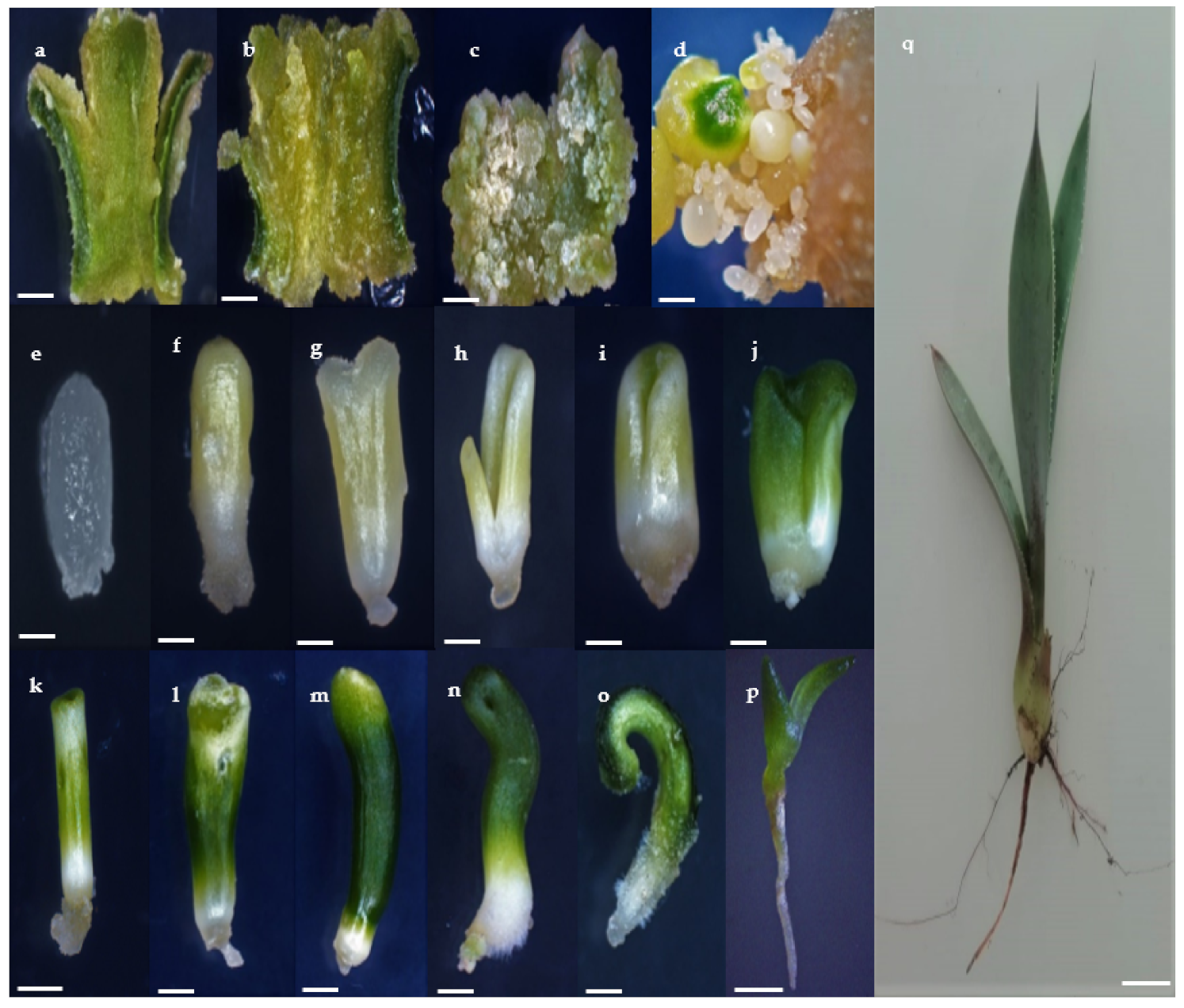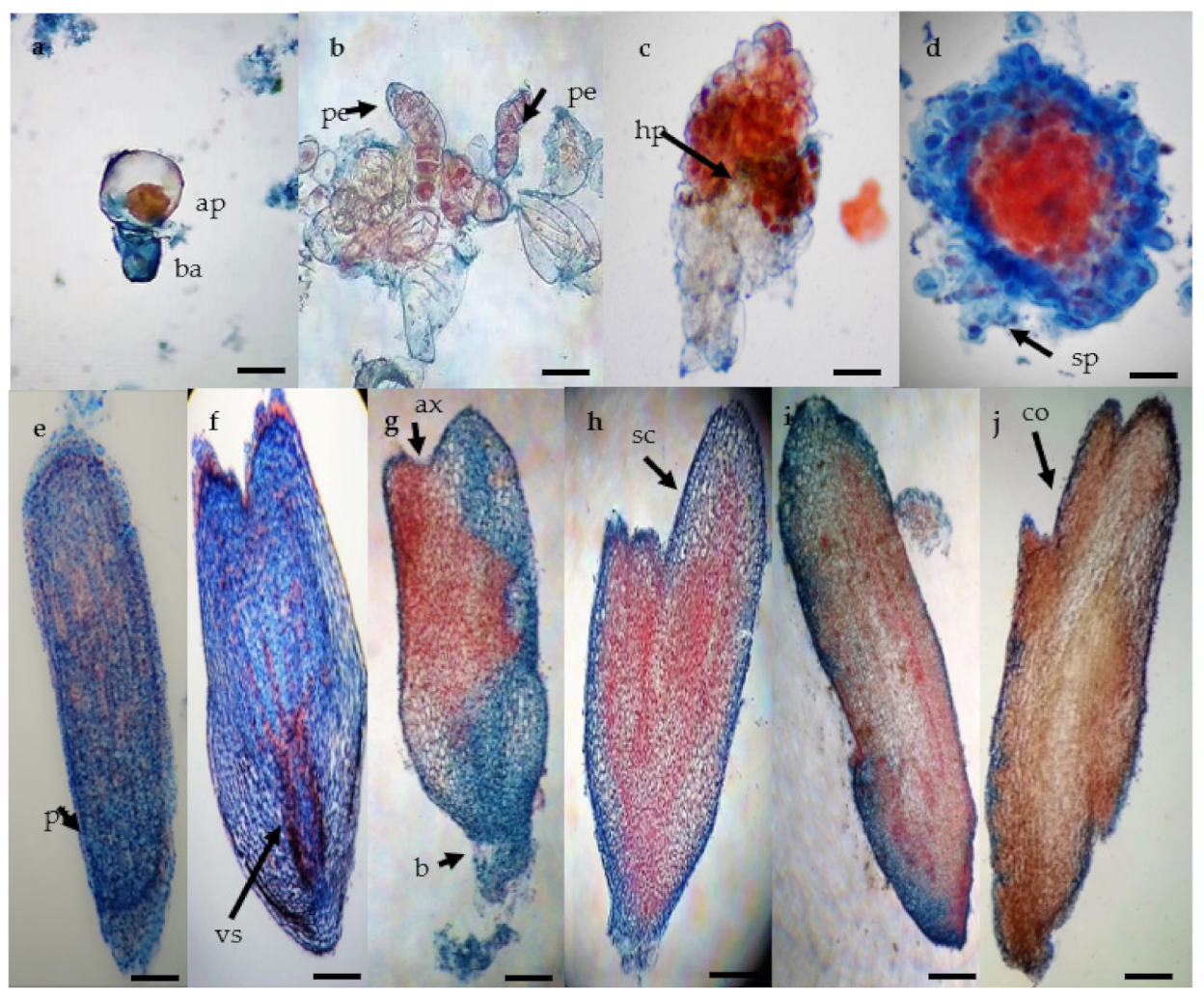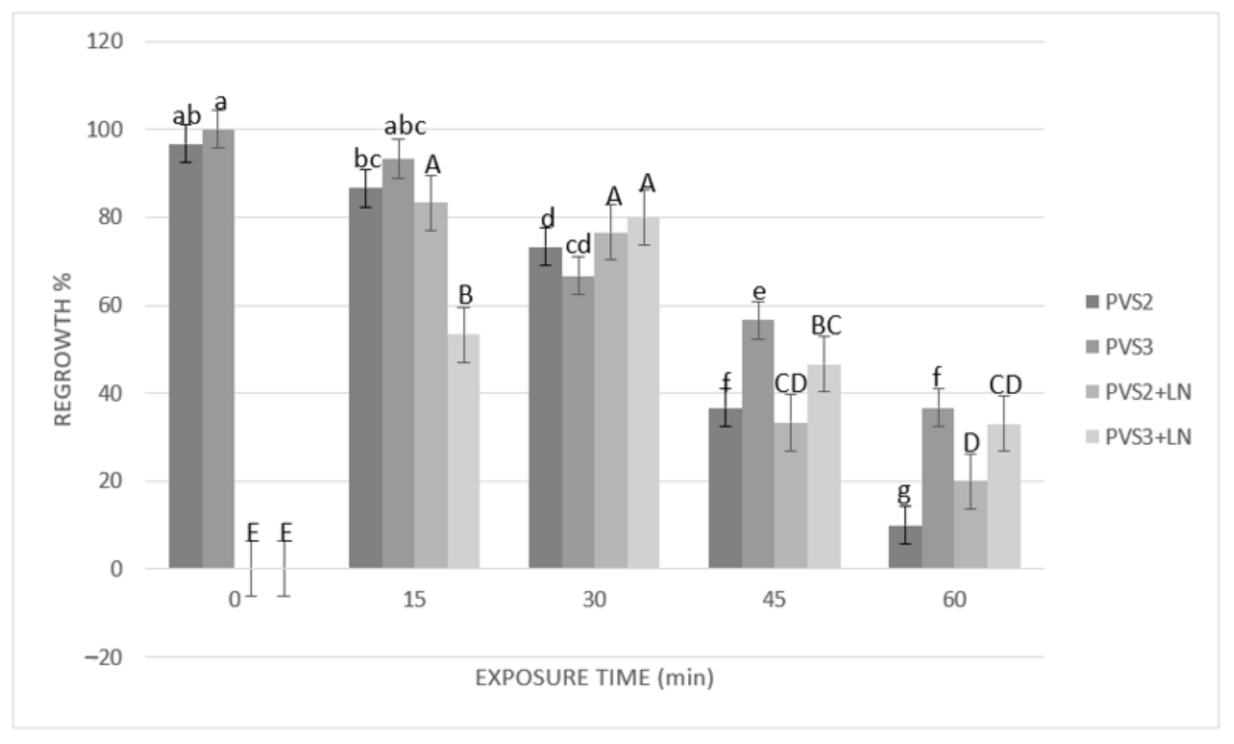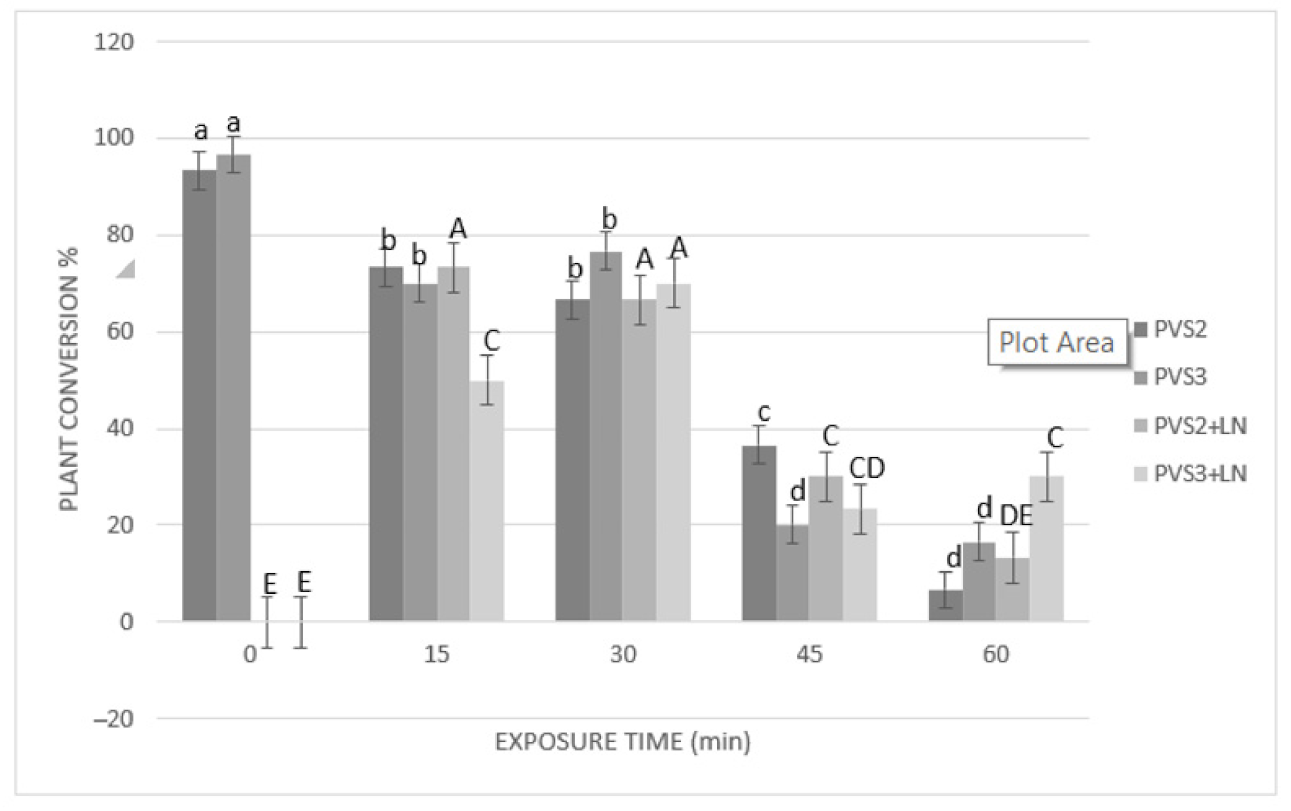Indirect Somatic Embryogenesis and Cryopreservation of Agave tequilana Weber Cultivar ‘Chato’
Abstract
1. Introduction
2. Results
2.1. Indirect Somatic Embryogenesis
2.2. Histological Observations
2.3. Cryopreservation by the V-cryoplate Method
3. Discussion
3.1. Indirect Somatic Embryogenesis
3.2. Histological Analysis
3.3. Cryopreservation by V-cryoplate Method
4. Materials and Methods
4.1. Induction of Indirect Somatic Embryogenesis
4.2. Histological Analysis
4.3. Cryopreservation of Somatic Embryos
4.4. Statistical Analysis
5. Conclusions
Author Contributions
Funding
Institutional Review Board Statement
Informed Consent Statement
Data Availability Statement
Conflicts of Interest
References
- Colunga-GarcíaMarín, P.; Zizumbo-Villarreal, D. Tequila and other agave spirits from west-central México: Current germplasm diversity, conservation and origin. Biodivers. Conserv. 2006, 16, 1653–1667. [Google Scholar] [CrossRef]
- Palomino, G.; Dolezel, J.; Méndez, I.; Rubluo, A. Nuclear genome size analysis of Agave tequilana Weber. Caryologia 2003, 56, 37–46. [Google Scholar] [CrossRef]
- Vargas-Ponce, O.; Zizumbo-Villarreal, D.; Martínez-Castillo, J.; Coello-Coello, J.; Colunga-Garciamarin, P. Diversity and structure of landraces of Agave grown for spirits under traditional agriculture: A comparison with wild populations of A. angustifolia (Agavaceae) and commercial plantations of A. tequilana. Am. J. Bot. 2009, 96, 448–457. [Google Scholar] [CrossRef] [PubMed]
- Delgado-Lemus, A.; Torres-García, I.; Vázquez, J.; Alejandro, C. Vulnerability and risk management of Agave species in the Tehuacán Valley, México. J. Ethnobiol. Ethnomed. 2014, 10, 53. [Google Scholar] [CrossRef] [PubMed]
- Zizumbo-Villarreal, D.; Vargas-Ponce, O.; Rosales-Adame, J.; Colunga-GarcíaMarín, P. Sustainability of the traditional management of Agave genetic resources in the elaboration of mescal and tequila spirits in western Mexico. Genet. Resour. Crop Evol. 2013, 60, 33–47. [Google Scholar] [CrossRef]
- Valenzuela, A. A new agenda for blue agave landraces: Food, energy and tequila. GCB Bioenergy 2011, 3, 15–24. [Google Scholar] [CrossRef]
- Diario Oficial de la Federación NOM-006-SCFI-2012 Proyecto de Norma Oficial Mexicana, Bebidas Alcohólicas-Tequila-Especificaciones. Available online: http://www.dof.gob.mx/nota_detalle.php?codigo=5282165&fecha=13/12/2012 (accessed on 8 June 2020).
- Rodríguez, F.; Martínez, L.; Palomera, C. Contextualización socioambiental del agave en Tonaya, Jalisco, México. Región Soc. 2017, 29, 71–102. [Google Scholar] [CrossRef]
- Powers, D.E.; Backhaus, R.A. In vitro propagation of Agave arizonica Gentry and Weber. Plant Cell Tissue Organ Cult. 1989, 16, 57–60. [Google Scholar] [CrossRef]
- Santacruz-Ruvalcaba, F.; Gutiérrez-Pulido, H.; Rodríguez-Garay, B. Efficient in vitro propagation of Agave parrasana Berger. Plant Cell Tissue Organ Cult. 1999, 56, 163–167. [Google Scholar] [CrossRef]
- Hazra, S.H.; Das, S.; Das, A.K. Sisal plant regeneration via organogenesis. Plant Cell Tissue Organ Cult. 2002, 70, 235–240. [Google Scholar] [CrossRef]
- Martínez-Palacios, A.; Ortega-Larrocea, M.P.; Chavez, V.M. Somatic embryogenesis and organogenesis of Agave victoria-reginae: Considerations for its conservation. Plant Cell Tissue Organ Cult. 2003, 74, 135–142. [Google Scholar] [CrossRef]
- Nikam, T.D.; Bansude, G.M.; Aneesh-Kumar, K.C. Somatic embryogenesis in sisal (Agave sisalana Perr. ex. Engelm). Plant Cell Rep. 2003, 22, 188–194. [Google Scholar] [CrossRef] [PubMed]
- Portillo, L.; Santacruz-Ruvalcaba, F.; Gutiérrez-Mora, A.; Rodríguez-Garay, B. Somatic embryogenesis in Agave tequilana Weber cultivar azul. Vitro Cell. Dev. Biol. Plant 2007, 43, 569–575. [Google Scholar] [CrossRef]
- Ramírez-Malagón, R.; Borodanenko, A.; Pérez-Moreno, L.; Salas-Araiza, M.D.; Nuñez-Palenius, H.G.; Ochoa-Alejo, N. In vitro propagation of three Agave species used for liquor distillation and three for landscape. Plant Cell Tissue Organ Cult. 2008, 94, 201–207. [Google Scholar] [CrossRef]
- Torres, I.; Casas, A.; Vega, E.; Martínez-Ramos, M.; Delgado-Lemus, A. Population dynamics and sustainable management of mescal agaves in central Mexico: Agave potatorum in the Tehuacán Cuicatlán valley. Econ. Bot. 2015, 20, 1–16. [Google Scholar] [CrossRef]
- Arzate-Fernández, A.; Piña-Escutia, J.L.; Norman-Mondragón, T.H.; Reyes-Díaz, J.I.; Guevara-Suárez, K.L.; Vázquez-García, L.M. Regeneration of agave (Agave angustifolia Haw.) from encapsulated somatic embryos. Rev. Fitotec. Mex. 2016, 39, 359–366. [Google Scholar]
- Carneiro, F.; Queiroz, S.R.; Passos, A.; Nascimento, M.; Santos, K. Embriogênese somática em Agave sisalana Perrine: Indução, caracterização anatômica e regeneração. Pesqui. Agropecuária Trop. 2014, 44, 294–303. [Google Scholar] [CrossRef][Green Version]
- González-Arnao, M.T.; Martínez-Montero, M.; Cruz-Cruz, C.A.; Engelmann, F. Advances in cryogenic techniques for the long-term preservation of plant biodiversity. In Biotechnology and Biodiversit, 1st ed.; Ahuja, M.R., Ramawat, K.G., Eds.; Springer: Rajasthan, India, 2014; Volume 4, pp. 129–170. [Google Scholar]
- Panis, B.; Withers, L.A.; De Langhe, E. Cryopreservation of Musa suspension cultures and subsequent regeneration of plants. CryoLetters 1990, 11, 337–350. [Google Scholar]
- Lambardi, M.; De Carlo, A.; Capuana, M. Cryopreservation of embryogenic callus of Aesculus hippocastanum L. by vitrification/one-step freezing. CryoLetters 2005, 26, 185–192. [Google Scholar]
- Yamamoto, S.; Rafique, T.; Priyantha, W.; Fukui, K.; Matsumoto, T.; Niino, T. Development of a cryopreservation procedure using aluminium cryo-plates. CryoLetters 2011, 32, 256–265. [Google Scholar]
- Niino, T.; Yamamoto, S.; Fukui, K.; Castillo-Martínez, C.R.; Valle, M.; Matsumoto, T.; Engelmann, F. Dehydration improves cryopreservation of mat rush (Juncus decipiens Nakai) basal stem buds on cryo-plates. CryoLetters 2013, 34, 549–560. [Google Scholar] [PubMed]
- Sakai, A.; Kobayashi, S.; Oiyama, I. Cryopreservation of nucellar cells of navel orange (Citrus sinensis Osb. var. brasiliensis Tnaka) by vitrification. Plant Cell Rep. 1990, 9, 30–33. [Google Scholar] [CrossRef] [PubMed]
- Sakai, A.; Engelmann, F. Vitrification, encapsulation-vitrification and droplet-vitrification: A review. CryoLetters 2007, 28, 151–172. [Google Scholar] [PubMed]
- Sánchez-Romero, C.; Sweenen, R.; Panis, B. Cryopreservation of olive embryogenic cultures. CryoLetters 2009, 30, 359–372. [Google Scholar] [PubMed]
- Adu-Gyamfi, R.; Wetten, A. Cryopreservation of cocoa (Theobroma cacao L.) somatic embryos by vitrification. CryoLetters 2012, 33, 494–505. [Google Scholar]
- Guzmán-García, E.; Bradaï, F.; Sánchez-Romero, C. Cryopreservation of avocado embryogenic cultures using droplet-vitrification method. Acta Physiol. Plant 2013, 35, 183–193. [Google Scholar] [CrossRef]
- Jiménez, V.M. Regulation of in vitro somatic embryogenesis with emphasis on the role of endogenous hormones. Rev. Bras. Fisiol. Veg. 2001, 13, 196–223. [Google Scholar] [CrossRef]
- Freire-Seijo, M. Aspectos básicos de la embriogénesis somática. Biotecnol. Veg. 2003, 3, 195–209. [Google Scholar]
- Namasivayam, P. Acquisition of embryogenic competence during somatic embryogenesis. Plant Cell Tissue Organ Cult. 2007, 90, 1–8. [Google Scholar] [CrossRef]
- Nhut, D.T.; Teixeira, J.A.; Aswath, C.R. The importance of the explant on regeneration in thin cell layer technology. Vitro Cell. Dev. Biol. Plant 2003, 39, 266–276. [Google Scholar] [CrossRef]
- Portillo, L.; Santacruz-Ruvalcaba, F. Obtención de embrioides de Agave tequilana Weber a partir de explantes de raíz. Zonas Áridas 2006, 10, 11–19. [Google Scholar]
- Monja-Mio, K.M.; Robert, M.L. Direct somatic embryogenesis of Agave fourcroydes Lem. through thin cell layer culture. Vitro Cell. Dev. Biol. Plant 2013, 49, 541–549. [Google Scholar] [CrossRef]
- Naziri, M.; Sadat, S.; Soltani, M. The effect of different hormone combinations on direct and indirect somatic embryogenesis in Agave americana. Plant Physiol. 2018, 9, 2739–2747. [Google Scholar]
- Rodríguez-Garay, B.; Gutiérrez-Mora, A.; Acosta-Dueñas, B. Somatic embryogenesis of Agave victoria-reginae Moore. Plant Cell Tissue Organ Cult. 1996, 46, 85–87. [Google Scholar] [CrossRef]
- Tejavathi, D.H.; Rajanna, M.D.; Sowmya, R.; Gayathramma, K. Induction of somatic embryos from cultures of Agave vera-cruz Mill. Vitro Cell. Dev. Biol. Plant 2007, 43, 423–428. [Google Scholar] [CrossRef]
- Flores-Benítez, S.; Jiménez-Bremont, J.F.; Rosales-Mendoza, S.; Argüello-Astorga, G.R.; Castillo-Collazo, R.A.; Alpuche-Solís, G. Genetic transformation of Agave salmiana by Agrobacterium tumefaciens and particle bombardment. Plant Cell Tissue Organ Cult. 2007, 91, 215–224. [Google Scholar] [CrossRef]
- Alvarez-Aragón, C.; Arzate-Fernández, A.M.; Martínez-Martínez, S.Y.; Martínez-Velasco, I. Regeneration of Agave marmorata roezl plants, by somatic embriogénesis. Trop. Subtrop. Agroecosyst. 2020, 23, 1–13. [Google Scholar]
- Santiz-Gómez, J.; Rincon-Rosales, R.; Gutiérrez-Miceli, F. In vitro propagation of Agave grijalvensis B.Ullrich, an endemic species from Chiapas under special protection. Gayana Bot. 2012, 69, 23–30. [Google Scholar]
- Takamori, L.M.; Barbosa, M.N.; Esteves, V.L.; Ferreira, R.A. Optimization of somatic embryogenesis and in vitro plant regeneration of Urochloa species using picloram. Vitro Cell. Dev. Biol. Plant 2015, 51, 554–563. [Google Scholar] [CrossRef]
- Beyl, C.A.; Sharma, G.C. Picloram induced somatic embryogenesis in Gasteria and Haworthia. Plant Cell Tissue Organ Cult. 1983, 2, 123–132. [Google Scholar] [CrossRef]
- Williams, E.G.; Maheswaran, G. Somatic embryogenesis: Factors influencing coordinated behavior of cells as an embryogenic group. Ann. Bot. 1986, 57, 443–462. [Google Scholar] [CrossRef]
- Ayala-González, C.; Gutiérrez-Mora, A.; Rodríguez-Garay, B. The occurrence of dicotyledonar embryos in Agave tequilana. Biol. Plant 2014, 58, 788–791. [Google Scholar] [CrossRef]
- George, E.F. Plant Tissue Culture Procedure-Background. In Plant Propagation by Tissue Culture, 3rd ed.; George, E.F., Hall, M.A., De Klerk, G.J., Eds.; Springer: Dordrecht, The Netherlands, 2008; Volume 1, pp. 1–28. [Google Scholar]
- Quiroz-Figueroa, F.R.; Fuentes-Cerda, C.F.J.; Rojas-Herrera, R.; Loyola-Vargas, V.M. Histological studies on the developmental stages and differentiation of two different somatic embryogenesis systems of Coffea arabica. Plant Cell Rep. 2002, 20, 1141–1149. [Google Scholar] [CrossRef]
- Haccius, B. Question of unicellular origin of non-zygotic embryos in callus cultures. Phytomorphology 1977, 28, 74–81. [Google Scholar]
- Halperin, W. In vitro embryogenesis: Some historical issues and unresolved problems. In In Vitro Embryogenesis in Plants, 1st ed.; Thorpe, T.A., Ed.; Kluwer Academic Publishers: Dordrecht, The Netherlands, 1995; Volume 20, pp. 1–16. [Google Scholar]
- Dodeman, V.L.; Ducreux, G.; Kreis, M. Zygotic embryogenesis versus somatic embryogenesis. J. Exp. Bot. 1997, 48, 1493–1509. [Google Scholar]
- Yamada, T.; Sakai, A.; Matsumura, T.; Higuchi, S. Cryopreservation of apical meristems of white clover (Trifolium repens L.) by vitrification. Plant Sci. 1991, 78, 81–87. [Google Scholar] [CrossRef]
- González-Arnao, M.T.; Pants, A.; Roca, W.M.; Escobar, R.H.; Engelmann, F. Development and large-scale application of cryopreservation techniques for shoot and somatic embryo cultures of tropical crops. Plant Cell Tissue Organ Cult. 2008, 92, 1–13. [Google Scholar] [CrossRef]
- González-Arnao, M.T.; Gámez, R.; Martínez, Y.; Valdés, S.; Mascorro, J.O.; Osorio, A.; Pastelín, M.; Guevara, M.; Cruz, C.A. Estado actual de la Crioconservación vegetal en México. In Crioconservación de Plantas en América Latina y el Caribe, 1st ed.; González-Arnao, M.T., Engelmann, F., Eds.; IICA: San José, Costa Rica, 2013; pp. 161–173. [Google Scholar]
- San José, M.D.C.; Corredoira, E.; Oliveira, H.; Santos, C. Cryopreservation of somatic embryos of Alnus glutinosa (L.) Gaertn. and confirmation of ploidy stability by flow cytometry. Plant Cell Tissue Organ Cult. 2015, 123, 489–499. [Google Scholar] [CrossRef]
- O’Brien, C.; Constantina, M.; Walia, A.; YuanYiing, J.; Mitter, N. Cryopreservation of somatic embryos for avocado germplasm conservation. Sci. Hortic. 2016, 211, 328–335. [Google Scholar] [CrossRef]
- Bradaï, F.; Almagro-Bastante, J.; Sánchez-Romero, C. Cryopreservation of olive somatic embryos using the droplet-vitrification method: The importance of explant culture conditions. Sci. Hortic. 2017, 218, 14–22. [Google Scholar] [CrossRef]
- Pettinelli, J.A.; Soares, B.O.; Collin, M.; Atalla, E.; Engelmann, F.; Gagliardi, R.F. Cryotolerance of somatic embryos of guinea (Petiveria alliacea) to V-cryoplate technique and histological analysis of their structural integrity. Acta Physiol. Plant 2020, 42, 1–10. [Google Scholar] [CrossRef]
- Murashige, T.; Skoog, F. A revised medium for rapid growth and bioassays with tobacco tissue cultures. Physiol. Plant 1962, 15, 473–497. [Google Scholar] [CrossRef]
- Phillips, G.C.; Collins, G.B. In vitro tissue culture of selected legumes and plant regeneration from callus cultures of red clover. Crop Sci. 1979, 19, 59–64. [Google Scholar] [CrossRef]
- Castro-Concha, L.; Loyola-Vargas, V.M.; Chan, J.L.; Robert, M.L. Glutamate dehydrogenase activity in normal and vitrified plants of Agave tequilana Weber propagated in vitro. Plant Cell Tissue Organ Cult. 1990, 22, 147–151. [Google Scholar] [CrossRef]
- Valenzuela-Sánchez, K.K.; Juárez, H.R.E.; Cruz, H.A.; Olalde, P.V.; Valverde, M.E.; Paredes, O. Plant regeneration of Agave tequilana by indirect organogenesis. Vitro Cell. Dev. Biol. Plant 2006, 42, 336–340. [Google Scholar] [CrossRef]
- Von Arnold, S. Somatic Embryogenesis. In Plant Propagation by Tissue Culture, 3rd ed.; George, E.F., Hall, M.A., De Klerk, G.J., Eds.; Springer: Dordrecht, The Netherlands, 2008; Volume 1, pp. 335–354. [Google Scholar]
- Quiroz-Figueroa, F.R.; Rojas-Herrera, R.; Galaz-Avalos, R.; Loyola-Vargas, V.M. Embryo production through somatic embryogenesis can be used to study cell differentiation in plants. Plant Cell Tissue Organ Cult. 2006, 86, 285–301. [Google Scholar] [CrossRef]
- Burger, L.M.; Richter, H.G. Anatomia da Madeira, 1st ed.; Livraria Nobel: São Paulo, Brazil, 1991; pp. 97–105. [Google Scholar]
- Gupta, P.; Durzan, D. Biotechnology of somatic polyembryogenesis and plantlet regeneration in loblolly pine. Bio/Technology 1987, 5, 147–151. [Google Scholar] [CrossRef]
- Yamamoto, S.; Rafique, T.; Fukui, K.; Sekizawa, K.; Niino, T. V-Cryo-plate procedure as an effective protocol for cryobanks: Case study of mint cryopreservation. CryoLetters 2012, 33, 12–23. [Google Scholar]
- Nishizawa, S.; Sakai, A.; Amano, Y.; Matsuzawa, T. Cryopreservation of asparagus (Asparagus officinalis L.) embryogenic suspension cells and subsequent plant regeneration by vitrification. Plant Sci. 1993, 91, 67–73. [Google Scholar] [CrossRef]





| Treatment | Concentration of Growth Regulators (µM) | Calli that Formed SEs % | Number of Somatic Embryos (Mean ± se) * | EFC | ||
|---|---|---|---|---|---|---|
| Picloram | BAP | |||||
| 1 | 24.84 | 2.21 | 56.25 | 10.93 ± 4.58 | fg | 6.15 |
| 2 | 33.13 | 2.21 | 68.75 | 16.18 ± 6.30 | def | 11.12 |
| 3 | 41.41 | 2.21 | 31.25 | 10.81 ± 9.17 | fg | 3.37 |
| 4 | 49.69 | 2.21 | 56.25 | 24.12 ± 4.00 | bc | 13.57 |
| 5 | 57.98 | 2.21 | 43.75 | 20.25 ± 5.61 | cde | 8.85 |
| 6 | 24.84 | 3.32 | 31.25 | 5.06 ± 2.29 | g | 1.58 |
| 7 | 33.13 | 3.32 | 62.50 | 13.37 ± 5.34 | ef | 8.35 |
| 8 | 41.41 | 3.32 | 93.75 | 29.43 ± 5.30 | b | 27.59 |
| 9 | 49.69 | 3.32 | 100.00 | 52.43 ± 5.74 | a | 52.43 |
| 10 | 57.98 | 3.32 | 75.00 | 21.87 ± 6.19 | bcd | 16.40 |
| 11 | 24.84 | 4.43 | 56.25 | 27.18 ± 2.33 | bc | 15.29 |
| 12 | 33.13 | 4.43 | 43.75 | 16.00 ± 4.15 | def | 7.00 |
| 13 | 41.41 | 4.43 | 31.25 | 4.56 ± 2.27 | g | 1.42 |
| 14 | 49.69 | 4.43 | 25.00 | 5.18 ± 1.40 | g | 1.29 |
| 15 | 57.98 | 4.43 | 37.50 | 9.37 ± 8.92 | fg | 3.51 |
Publisher’s Note: MDPI stays neutral with regard to jurisdictional claims in published maps and institutional affiliations. |
© 2021 by the authors. Licensee MDPI, Basel, Switzerland. This article is an open access article distributed under the terms and conditions of the Creative Commons Attribution (CC BY) license (http://creativecommons.org/licenses/by/4.0/).
Share and Cite
Delgado-Aceves, L.; González-Arnao, M.T.; Santacruz-Ruvalcaba, F.; Folgado, R.; Portillo, L. Indirect Somatic Embryogenesis and Cryopreservation of Agave tequilana Weber Cultivar ‘Chato’. Plants 2021, 10, 249. https://doi.org/10.3390/plants10020249
Delgado-Aceves L, González-Arnao MT, Santacruz-Ruvalcaba F, Folgado R, Portillo L. Indirect Somatic Embryogenesis and Cryopreservation of Agave tequilana Weber Cultivar ‘Chato’. Plants. 2021; 10(2):249. https://doi.org/10.3390/plants10020249
Chicago/Turabian StyleDelgado-Aceves, Lourdes, María Teresa González-Arnao, Fernando Santacruz-Ruvalcaba, Raquel Folgado, and Liberato Portillo. 2021. "Indirect Somatic Embryogenesis and Cryopreservation of Agave tequilana Weber Cultivar ‘Chato’" Plants 10, no. 2: 249. https://doi.org/10.3390/plants10020249
APA StyleDelgado-Aceves, L., González-Arnao, M. T., Santacruz-Ruvalcaba, F., Folgado, R., & Portillo, L. (2021). Indirect Somatic Embryogenesis and Cryopreservation of Agave tequilana Weber Cultivar ‘Chato’. Plants, 10(2), 249. https://doi.org/10.3390/plants10020249







